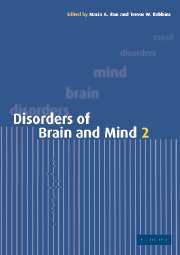Book contents
- Frontmatter
- Contents
- List of contributors
- Preface
- Part I Genes and behaviour
- Part II Brain development
- 3 Brain development: glial cells generate neurons – implications for neuropsychiatric disorders
- 4 Brain development: the clinical perspective
- Part III New ways of imaging the brain
- Part VI Imaging the normal and abnormal mind
- Part V Consciousness and will
- Part IV Recent advances in dementia
- Part VII Affective illness
- Part VIII Aggression
- Part IX Drug use and abuse
- Index
- Plate section
- References
3 - Brain development: glial cells generate neurons – implications for neuropsychiatric disorders
from Part II - Brain development
Published online by Cambridge University Press: 19 January 2010
- Frontmatter
- Contents
- List of contributors
- Preface
- Part I Genes and behaviour
- Part II Brain development
- 3 Brain development: glial cells generate neurons – implications for neuropsychiatric disorders
- 4 Brain development: the clinical perspective
- Part III New ways of imaging the brain
- Part VI Imaging the normal and abnormal mind
- Part V Consciousness and will
- Part IV Recent advances in dementia
- Part VII Affective illness
- Part VIII Aggression
- Part IX Drug use and abuse
- Index
- Plate section
- References
Summary
Introduction
A variety of neurological disorders may have their origin during development of the central nervous system (CNS) (see also Chapter 4 by Beasley et al.). In particular, disorders with displaced neurons are considered as a failure of neuronal migration and have therefore been named ‘neuronal migration disorders’ (NMD). NMDs occur rather frequently in the forebrain and comprise aberrations in the formation of gyri, heterotopia and dysplasia (Copp and Harding 1999; Walsh 1999; Lammens 2000; Clark 2001). In cases of heterotopia, neurons are located in the white matter (WM), the fibre tract of the CNS, where usually only somata of glial cells (astrocytes and oligodendrocytes) reside. Dysplasia is a focal malformation in the grey matter (GM) of the cerebral cortex (focal cortical dysplasia (FCD)), the dorsal part of the telencephalon. The grey matter contains the neurons that are arranged in horizontal layers in the cerebral cortex according to their functional properties and connectivity (Götz 1999). This layering is often distorted in dysplasia and large abnormal neurons can be detected (Cotter et al. 1999). Similarly, a variety of defects assigned to developmental stages have been detected in patients with schizophrenia, leading to the highly disputed ‘neurodevelopmental hypothesis’ of this complex disorder (Senitz 1984; Jakob and Beckmann 1994; Roberts et al. 1995; Hollister and Cannon 1998; Taylor 1998; see also Chapter 4 by Beasley et al.).
These malformations in the adult are assigned to developmental processes as smoke is considered an indication of a fire.
- Type
- Chapter
- Information
- Disorders of Brain and Mind , pp. 59 - 73Publisher: Cambridge University PressPrint publication year: 2003



